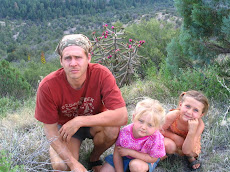.

Today was our first wild edible plant walk, and it started snowing in the morning. By noon it was coming down heavily and sticking - very unusual for Atlanta. I drove over to the Chattahoochee River in almost blizzard conditions. The flakes were large and blowing thickly. All the edible weeds were covered in snow. And it was still snowing heavily and freezing.
Mishka and I took a hike down the loop trail to see what edible plants I might still be able to point out. It was hard to see anything. And the trail was underwater. It was actually flowing in places (we've had 2 days of heavy rain). Even the beautiful scene of forsythia and oregon-grape flowering side by side was almost invisible in the haze of snow. Here's a photo of it:

Nobody showed up for the walk anyway, considering the weather, so we'll reschedule for next week.
I'm going to come over to this trailhead every day after work to continue to study the plants and harvest weeds for my daily green smoothies. The diversity is incredible, and the bottomlands are rich habitat.
Day 7 going 100% raw was hardly challenging - each day it gets easier. I had a green smoothie with parsley for lunch, and for dinner, my stuffed red bell peppers:

These were so good! Heavy and filling, but simple, and high-enzyme. Here's how I made them:
I soaked 2 cups of sunflower seeds last night. This morning I rinsed them and left them in the strainer. By afternoon the sprouting process had begun. I put them in a food processor with one small bunch of fresh mint (it was so fresh and aromatic and new baby leaves were coming out), a very small bit of red onion, chopped. I put in the juice of 3 small lemons, and a little Real Salt (I prefer Celtic, but don't have it right now - dulse flakes or kelp would be even better). I processed it until everything was smooth. I then spooned it into the peppers.
I also continue to read books on raw foods so mentally I stay focused. This past week I've read Victoria Boutenko's 'Raw Family', '12 Steps to Raw Foods', and 'Green for Life'. I love her approach, and acknowledgement of the addictive nature of cooked food. I'm now reading 'How to Have the Best Odds of Avoiding Degenerative Disease,' by Don Bennett, a guy I know from when we had a strong raw food movement here in Atlanta and Sprout Cafe was open and we met there for potlucks.
A full week accomplished! I haven't lasted that long in years. The first 60 days are the toughest. Then it becomes more habitual. Humans if nothing else are creatures of habit.
.
 The Ebbing's silverberries (elaeagnus ebbingei) are now definitely ripe, and I picked a quart of them this morning:
The Ebbing's silverberries (elaeagnus ebbingei) are now definitely ripe, and I picked a quart of them this morning: I'm going to have to reverse my former opinion of these silverberries, and rank them very high as a wild food. Ripe berries in March! It's incredible. Those that are red and firm have a slight acid astringency and the flavor of lemon. When they're ripe they soften and almost liquefy into a raspberry/strawberry jam - very, very good. It only took me an hour to pick this quart. The berries still have large pits, so only the rind is edible - but it is very tasty.
I'm going to have to reverse my former opinion of these silverberries, and rank them very high as a wild food. Ripe berries in March! It's incredible. Those that are red and firm have a slight acid astringency and the flavor of lemon. When they're ripe they soften and almost liquefy into a raspberry/strawberry jam - very, very good. It only took me an hour to pick this quart. The berries still have large pits, so only the rind is edible - but it is very tasty.
 And Mishka loves them!
And Mishka loves them! He begged and begged to try some. I finally gave him a bunch in a bowl because I was sick of hand-feeding him. He eats them pits and all. It is actually natural for dogs to eat berries - they're omnivores. Coyotes will not only eat berries when they're ripe, they'll eat all the bear scat after the bear's eaten berries - this was something I witnessed camping long-term up on Pigeon Mtn. I even came across a coyote chasing a turkey once down the dirt road.
He begged and begged to try some. I finally gave him a bunch in a bowl because I was sick of hand-feeding him. He eats them pits and all. It is actually natural for dogs to eat berries - they're omnivores. Coyotes will not only eat berries when they're ripe, they'll eat all the bear scat after the bear's eaten berries - this was something I witnessed camping long-term up on Pigeon Mtn. I even came across a coyote chasing a turkey once down the dirt road.

 These were so good! Heavy and filling, but simple, and high-enzyme. Here's how I made them:
These were so good! Heavy and filling, but simple, and high-enzyme. Here's how I made them:



